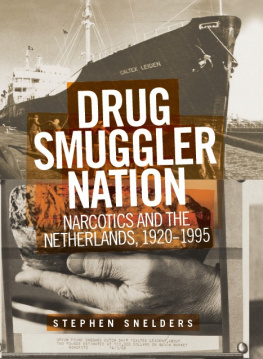1
Introduction: The drug regulatory regime vs. criminal anarchy
These estimates give some kind of indication of the economic value of the illegal drug trade, even when based on limited data provided by police detective units and only giving approximate indications of the total volume of the illegal drug trade. The estimates do not give an idea of other major impacts of the drug trade on society, such as cross-overs with and financing of other criminal activities, entanglements with the legitimate economy, corruption and threatening of civil servants, and effects on public and individual health. States and civil society are struggling with the unintended consequences of drug regulatory policies and the successes of the drug trade, such as problems of addiction, overdoses, and gang wars. Of crucial importance in coming to terms with these consequences is an understanding of the patterns and nature of the illegal drug trade.
The rise and implementation of an international drug regulatory regime in the twentieth century restricted and transformed the traditional Dutch production and trade in drugs. At the same time it created new opportunities for Dutch entrepreneurs. The increasing state regulations and interventions necessary to control the illegal drug trade and consumption, combined with the increasing public demand for these illegal drugs, led to the proliferation of a hydra of small, anarchic groups and networks ideally suited to circumventing the enforcement of regulation. When one head of this hydra was chopped off, another one grew in its place. In the course of the twentieth century these groups and networks included sailor smugglers, idealists from countercultural drug scenes, and criminal opportunists. They included native Dutch people as well as criminal entrepreneurs from other ethnic backgrounds in the Netherlands (Chinese, Turkish, and Kurdish, Moroccan etc.). They were often working together in temporary alliances, and in tandem with a legitimate upperworld, especially within the chemical and maritime industries. Smugglers in the Netherlands used the excellent logistics and infrastructure of the country and its superb connections by ship, train, or plane to places of supply and demand, and stimulated the development of illegal drug production, from Afghanistan to Morocco. Smugglers transformed the Netherlands into a transit hub for the international drug trade, supplying other European countries and the UK. They developed direct and indirect connections between supply countries and demand in the Americas. They also created a thriving underground industry of illegal synthetic drug laboratories and indoor cannabis cultivation in the Netherlands itself.
In order to understand the patterns in the rise of the illegal drug trade and its relation to organized crime, from the enactment of the first Dutch drug law in 1920 to the parliamentary and societal debates around 1995, this book synthesizes the results of case studies of and reports on twentieth-century illegal drug smuggling and production works by historians, criminologists, and investigative journalists together with archival research. The (often bewildering) multiplications of the supply side of the market are investigated from the perspective of their emergence and development as the necessary antithesis to the creation and implementation of a drug regulatory regime by the state.
The global drug regulatory regime
Although this book is not primarily concerned with the grounds and dynamics of this regime, a short overview of its development is in order.
The global drug regulatory regime worked from the international level (multilateral treaties between states and from 1919 onwards supervision by supra-national organizations, the League of Nations, and the United Nations) to the local level (legislation and policies of states) in order to control non-medical and recreational use of prohibited drugs. In doing so the regime created a reaction that went the other way: non-state actors such as criminal entrepreneurs and their networks started activities at the local level (e.g., cultures of smuggling in cities and provinces) and expanded internationally. This led to more global regulation and prohibition that led again to more opportunities for local entrepreneurs to expand their activities.
).
Attempts at global drug regulation started in the early 1900s. The United States and China especially promoted the enactment of drug regulation in international law and international treaties. The meetings of the International Opium Commission in Shanghai in 1909 and the International Opium Conference in The Hague in the Netherlands in 1912 led to the first international opium convention. This convention was aimed at controlling the non-medical and illegitimate use of opium and opiates derived from opium such as morphine and heroin, as well as of cocaine. (The latter three drugs were all relatively new substances that had been developed by the pharmaceutical industry in the nineteenth century.) The United States particularly became the driving force behind prohibitionist global drug regulation. As political scientist David Bewley-Taylor has written:
Since the 1909 Shanghai Commission meeting, international drug regulation has been driven by the imperative of further regulation. This because, as will be seen throughout this book, interventions by international bodies and national states encountered practices of smuggling and supply by non-state actors. This had already started in the interwar period. These actors responded on a national and an international level to a continuing, and from 1965 onwards even massively increasing, demand for illicit drugs. In other words, the very lack of success in actually controlling drug use necessitated a continual expansion of the prohibitive framework.






